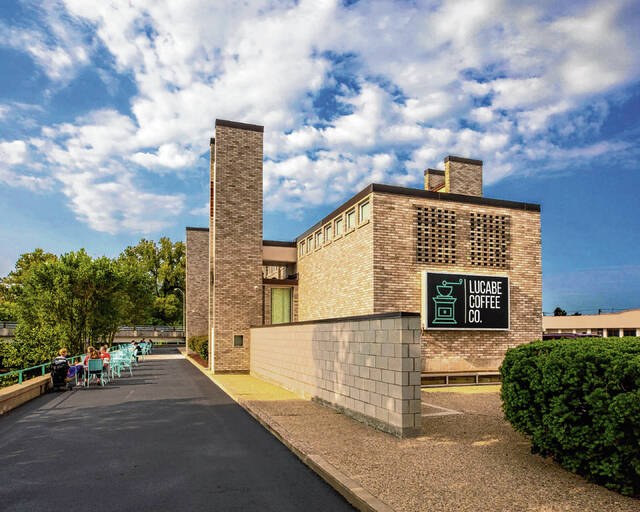
Photo provided by Hadley Fruits The exterior of the new Lucabe Coffee Co. in a former Harry Weese-designed bank building.
Tyler and Alissa Hodge have deposited plenty of money, time, effort and expertise into a former long-time local bank.
Their payback, now and over the next few years, comes in knowing that they have helped preserve a part of Columbus’ Modernist architectural legacy.
All while serving everything from coffee to croissants.
So it is with their second Lucabe Coffee Co. location, this one along Haw Creek at 2531 Eastbrook Plaza Shopping Center in Columbus (the original location, opened in 2017, remains at 310 Fourth St.).
Longtime local residents know the 5,000-square-foot structure, designed by world-renowned, Chicago-based architect Harry Weese, originally as an Irwin Union Bank and Trust that later became First Financial Bank until spring 2020.
The Columbus couple and owners fully opened the new, 50-seat location in September. Tyler Hodge considered what the late Weese might think about what The Architect’s Newspaper called a “banking-to-beans adaptive reuse project.”
“I hope that he would be pleased,” said the co-owner, standing on the structure’s original, shiny gray slate flooring that is a story in itself when it comes to its fairly incredible, multi-step resurrection from years and layers of carpet glue and goo. “I hoped that he would like how we integrated a lot of his original design elements throughout and tried to restore the building’s original character.”
With the exception of a library-looking, nearly private study nook on the building’s second-level west end, they have ditched window blinds to let the sun shine in and make the atmosphere a festival of light. The owners have left the real vault and its door on the other end of the building to transform it into a whimsical children’s play area with a small climbing wall. They have made what once was a teller area the space where baristas now work their magic.
But it’s the elongated, oak and quartz bar that looks for all the world like an older-style bank counter.
Clearly, the outstanding balance here is one between the past and present, and the Modernist and modernized. Maybe like mixing the ingredients of a good latte.
“Alissa and I knew we had only one chance to do this well,” Hodge said, “and to include that wow factor in the surroundings.”
He figures energetic ambience helps customers perk up perhaps as much as a good cup of java.
Pastor Randy Burton, now a regular customer, has fallen in love with more than the menu. He’s an area native who remembers when a family member served as branch manager.
“This has become my favorite place,” Burton said Monday afternoon while eating with out-of-town guests at the shop. “I think it’s great that they could restore this, and not have to tear down something in order to build something else.”
Yet, refurbishing a 60-year-old, weary structure in need of multiple, major “surprise” repairs took perseverance, according to the owners. One such challenge was finding early on that some areas of the worn brick facade and some areas of mortar leaked substantially because of cracks.
Another basic challenge was rolling the dice on an edifice whose downstairs had been hit hard by the 2008 flood.
But key construction crew workers such as Abe Skinner, of Skinner’s Custom Construction, who also worked on the original Lucabe location, beamed with a bit of pride Monday afternoon when he walked in.
“It’s always good to see a building like this come back to life,” said Skinner.
The Landmark Columbus Foundation worked with the Hodges offering guidance on transforming the structure to a new use while preserving its design integrity.
“We hope that projects like this inspire others (on reuse),” said Richard McCoy, the foundation’s executive director.
Tyler Hodge laughed when lightheartedly asked if he wished they could have found a way to send coffee or menu sides through the bank drive-through tubes that had to be removed during the transformation.
“Oh,” he said. “The (former Cummins) engineer in me wanted to be able to do something like that.”




